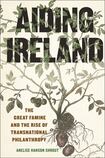
It is a common misconception that charity is by definition selfless. In fact, there are usually other motivations behind humanitarian aid than just the alleviation of distress. In Aiding Ireland, historian Anelise Hanson Shrout addresses this topic in relation to the transnational philanthropic response to the Great Famine. Her convincing study explores why people from so many places and backgrounds donated, and reveals their underlying agendas. Without minimising the generosity of donors, she complicates prevalent and often simplistic narratives about famine-era philanthropy.
The Famine occurred during a time when philanthropy became increasingly international, and the charitable response was “one of the first truly global humanitarian efforts”, as Shrout and others have shown. But this accessible monograph argues that this response exemplifies the Famine’s capaciousness as a symbol made to represent “multiple, conflicting meanings simultaneously” and mobilised for a wide range of political and ideological concerns. As such, the book’s main purpose is not to give an overview of who gave what exactly, though it builds on defining work in that area, such as Christine Kinealy’s Charity and the Great Hunger in Ireland.
The first two chapters focus on Irish and British aid, and how different actors used the crisis to promote political causes, such as Irish nationalism or the legislation of free trade. The third chapter examines how the Famine was used both to resist and to justify empire, depending on commentators’ political objectives. This is fairly well-trodden ground, but Shrout’s careful tracing of these dimensions provides insight into the Famine’s broader social and political contexts.
The bulk of Aiding Ireland focuses on the United States, and this is where Shrout’s analysis is most original. Chapter 4 demonstrates how discussions surrounding aid for Ireland were intertwined with the question of America’s emerging position in relation to the British Empire. She offers a perceptive examination of two leading newspapers, the New York Herald and the New York Tribune, which situated aid for famishing Ireland within the framework of American party politics.
Chapter 5 draws links between the landlord system in Ireland and the Anti-Rent Wars in New York state, a campaign similar to agricultural resistance in Ireland. This was partly instigated by Donegal native Thomas Ainge Devyr, a radical activist who had fled across the Atlantic a few years before the famine. The comparison is instructive, and indeed Shrout shows that US media explicitly noted parallels between the situation in New York state and famishing Ireland’s status as a British colony.
In chapters 6 and 7, Shrout explores the nexus between famine aid and slavery. She shows how enslavers in the US south donated publicly to exhibit their so-called humanity. Spuriously, they drew parallels between British colonial government and the US north’s disapproval of slavery. Moreover, they presented the condition of Ireland’s peasantry as comparative “proof” that the plantation system from which their wealth derived was much more benign than abolitionists asserted.
Shrout juxtaposes this repulsive discourse with donations, however small, from enslaved and free Black donors, such as congregants of the First African Baptist Church in Richmond, Virginia. Such potentially dangerous gifts, she argues, constituted “deliberate use of white charitable norms to challenge white claims of black inhumanity”, and undermined the rhetoric of enslaver philanthropy.
The book’s final chapter has particular resonance today, as it complicates popular narratives regarding the well-known gifts from the Choctaw and Cherokee nations. Generally, these indigenous donations are celebrated simply as an expression of solidarity from one oppressed people to another. This not only obscures the often violent role Irish immigrants and their descendants played in settling North America, but also the deeper political significance of these contributions. Christian missionaries unsurprisingly sought to claim them as proof of assimilation – “evidence of civilisation and Christian spirit existing among our red neighbours”, as the Arkansas Intelligencer editorialised patronisingly. Yet Shrout argues that they were in fact acts of resistance against the dehumanising rhetoric of settler colonialism, and represent a history of philanthropy predating assimilationist operations.
However, while religion features in a number of chapters, and the Quakers, crucial humanitarian agents in many famines, are mentioned frequently, the book somewhat surprisingly lacks a broader analysis of the often heavily politicised religious dimensions of famine-era charity. This includes the role of the Catholic Church as well as explicitly Protestant initiatives at home and abroad, such as evangelical fundraisers in North America, or the Irish Church Missions with their persistent (if somewhat overstated) whiff of souperism.
Shrout’s argument about the Famine’s malleable symbolism is convincing, but could have been strengthened further by some engagement with the scholarship on the cultural and literary heritage of the Famine, where similar ideas have long circulated. All the same, this is a well-argued and highly welcome monograph that offers a compelling account of the political and ideological dimensions of humanitarian aid during the Famine.













